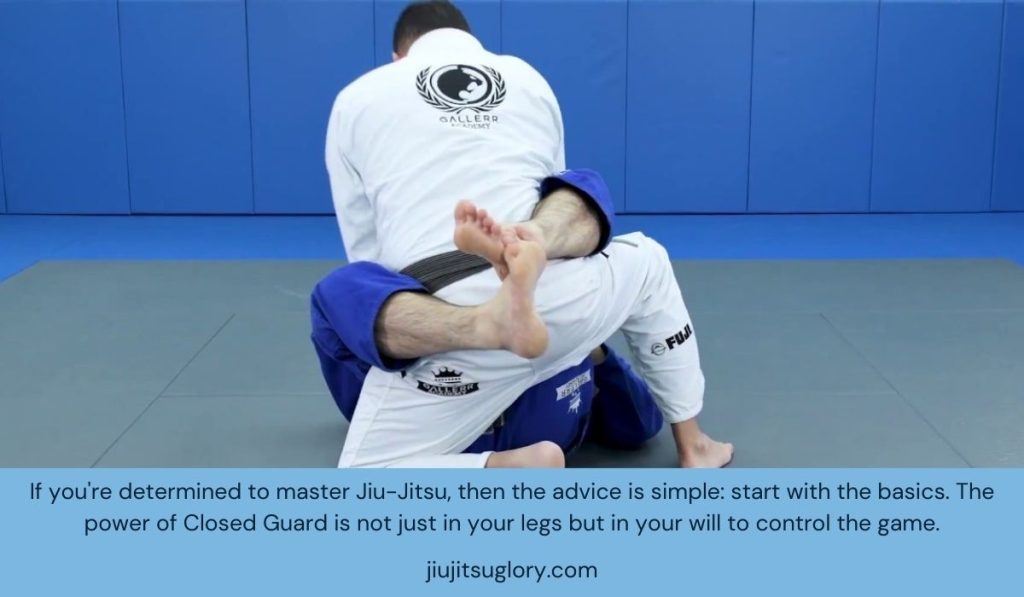Learning the basic jiu-jitsu positions is crucial to being successful in grappling martial arts.
So, Whether you’re just starting your grappling journey or a seasoned practitioner looking to refine your skills, understanding jiu-jitsu positions will undoubtedly enhance your overall performance.
In this article, I will talk about the basic Jiu-Jitsu positions, their importance, and how they can be used to gain an advantage. Stay tuned!

Basic Jiu-Jitsu Positions
Closed Guard
The Closed Guard is one of the most fundamental positions in Jiu Jitsu. In this position, I am on my back with my legs wrapped around my opponent’s waist, effectively trapping them between my legs.
This Jiu-Jitsu Guard offers excellent control over the opponent, limiting their movement and opportunities for attacking. It also provides defensive options such as submissions and sweeps.
To maintain the Closed Guard, I must keep my legs locked tightly around my opponent’s waist, maintaining a solid grip. This prevents them from posturing up and breaking the guard.
In addition, I can utilize a wide range of techniques from the Closed Guard, including attacks such as armbars, triangles, or sweeps, to gain a dominant position.

Open Guard
The Open Guard is where my legs are free, allowing for a more dynamic and mobile approach.
In Open Guard, I can use various grips and leg configurations to control my opponent and create attack opportunities. This position is highly versatile and provides many offensive and defensive options.
With my legs free, I can use my feet, knees, and hands to control my opponent’s balance and prevent them from passing my guard.
From the Open Guard, I can transition into other positions, such as the Butterfly Guard or Spider Guard, to enhance my attacking options further.
Maintaining distance and adjusting my position is essential to prevent my opponent from establishing control and passing my guard.
See Also: How Many Calories Does Jiu-Jitsu Burn?
Half Guard
The half-guard is a transitional position when my opponent manages to pass one of my legs while attempting to escape or pass my guard.
In this position, I am on my back with one leg trapped between my opponent’s legs while the other is free. And I have both offensive and defensive options.
From the bottom Half Guard, I can work towards sweeping my opponent and regaining a more advantageous position, such as the top position or Closed Guard.
Various sweeps and submissions can be executed from the Half Guard, making it a versatile position to attack.
On the other hand, from the top Half Guard, I can apply pressure and look for opportunities to pass my opponent’s guard.
Side Control
Side Control is a dominant position in Jiu Jitsu, where I am on top of my opponent, pinning them to the ground on their side.
This position offers excellent control and exposes my opponent to various attacks and transitions.
From Side Control, I have multiple options to submit my opponent or transition to more advantageous positions.
In Side Control, I must maintain strong shoulder and hip pressure on my opponent to restrict their movement.
I can set up submissions such as the Kimura or Americana by isolating their arms or controlling their head.
Transitioning to a mount or a more secure control position like the back control can also be achieved from Side Control.
Mount
The Mount position is indeed a dominant and high-percentage position in Jiu Jitsu.
In this jiu-jitsu position, I am on top of my opponent, straddling their chest with my knees. The Mount offers excellent control and opportunities for both striking and submission techniques.
To maintain the Mount, I must distribute my weight evenly over my opponent, ensuring a solid base to prevent them from escaping.
Otherwise, I can deliver strikes from the Mount to weaken my opponent or transition to submissions such as the Armbar or Triangle Choke.
The Mount position also provides a smooth pathway to the Back Control position, allowing for further control and submission opportunities.
See Also: Does Jiu Jitsu Have Striking? A Deep Dive
Back Control
The Back Control position is considered the ultimate control position in Jiu Jitsu. In Back Control, I am behind my opponent, straddling their back with my legs and controlling their upper body.
Indeed, the Back Control offers exceptional control, making attacking and submitting to the opponent easier.
From Back Control, I can secure a Rear Naked Choke, one of the most potent submissions in Jiu-Jitsu.
This essential jiu-jitsu position also presents opportunities for transitions to different positions, such as transitioning to an armbar or a Bow-and-Arrow Choke if the opponent starts to defend the rear naked choke.
Maintaining control of both hooks and ensuring a tight grip to prevent the opponent from escaping is crucial.
North-South
The North-South position is a transitional position where I have moved from a top control position, such as Side Control or Mount, to a position where I am perpendicular to my opponent’s body.
I can control their movements and attack from different angles in this position.
I can apply submissions from the North-South position, such as the Kimura, or transition to other control positions, like the Mount or Side Control.
Otherwise, this jiu-jitsu position also provides opportunities to apply pressure to exhaust or immobilize the opponent before securing a submission.
Knee on Belly
The Knee-on-belly position is unique because I am on top of my opponent, placing a knee on their abdomen while keeping my other leg free.
This position can be used to control the opponent and set up various attacks.
From Knee to Belly, I can transition to different positions depending on my objectives.
I can transition to the Mount or Side Control or use it to create space for attacks such as knee strikes, chokes, or submissions such as the Baseball Bat Choke or Armbar.
Turtle Position
The Turtle Position is a defense position that can occur when my opponent manages to take my back.
In the jiu-jitsu turtle position, I am on all fours, protecting my neck and limbs while preparing to escape or defend against my opponent’s attacks.
I can aim to escape and regain a more advantageous position from the Turtle Position, such as a Standing Position or Guard.
Techniques like the Granby Roll or Sit-out can be employed to escape from the Turtle Position and avoid getting trapped or submitted.
Standing Position
The Standing Position is the starting point of a Jiu-Jitsu match, where both competitors are on their feet.
While it is not a position used extensively during ground fighting, understanding the principles of proper stance and balance is essential to maintain control and prevent being taken down.
In the Standing Position, it is crucial to establish a strong base, maintain good posture, and utilize effective grips.
Knowing takedowns, throws, and sweeps becomes necessary as the fight progresses to gain an advantage and transition into dominant positions on the ground.
Conclusion
Any Jiu-Jitsu practitioner must have a firm grasp of the fundamental positions. These positions are the foundation for executing techniques, maintaining control, and setting up submissions.
By studying and mastering each position, I can improve my overall Jiu-Jitsu skills and become a well-rounded and successful practitioner.


